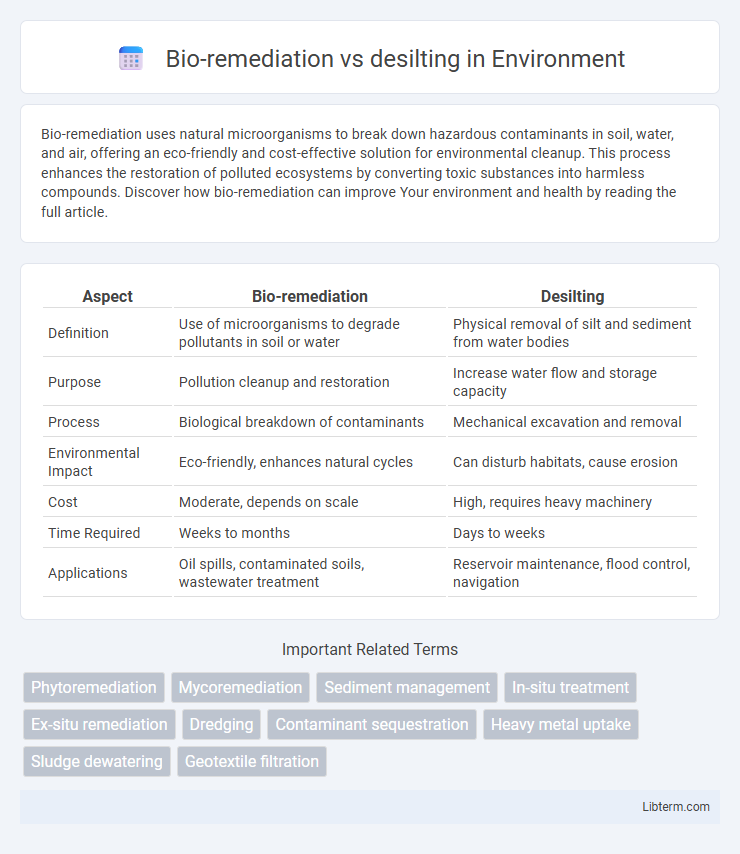Bio-remediation uses natural microorganisms to break down hazardous contaminants in soil, water, and air, offering an eco-friendly and cost-effective solution for environmental cleanup. This process enhances the restoration of polluted ecosystems by converting toxic substances into harmless compounds. Discover how bio-remediation can improve Your environment and health by reading the full article.
Table of Comparison
| Aspect | Bio-remediation | Desilting |
|---|---|---|
| Definition | Use of microorganisms to degrade pollutants in soil or water | Physical removal of silt and sediment from water bodies |
| Purpose | Pollution cleanup and restoration | Increase water flow and storage capacity |
| Process | Biological breakdown of contaminants | Mechanical excavation and removal |
| Environmental Impact | Eco-friendly, enhances natural cycles | Can disturb habitats, cause erosion |
| Cost | Moderate, depends on scale | High, requires heavy machinery |
| Time Required | Weeks to months | Days to weeks |
| Applications | Oil spills, contaminated soils, wastewater treatment | Reservoir maintenance, flood control, navigation |
Introduction to Bio-remediation and Desilting
Bio-remediation involves using microorganisms or plants to break down or remove contaminants from soil and water, offering an eco-friendly solution for pollution management. Desilting is the mechanical process of removing silt, sediment, and debris from water bodies like rivers, lakes, and reservoirs to restore water flow and storage capacity. Both methods play crucial roles in environmental management, with bio-remediation focusing on contaminant degradation and desilting targeting sediment accumulation.
Defining Bio-remediation: Principles and Approaches
Bio-remediation involves the use of microorganisms or plants to degrade, detoxify, or remove pollutants from soil and water, relying on natural metabolic processes to restore environmental quality. Key principles include microbial metabolism, enzymatic breakdown of contaminants, and environmental factors such as pH, temperature, and nutrient availability that influence degradation rates. Approaches to bio-remediation vary from in situ techniques like phytoremediation and bioventing to ex situ methods including biopiles and bioaugmentation, each tailored to specific contaminant types and site conditions.
Understanding Desilting: Methods and Processes
Desilting involves the mechanical removal of accumulated silt and sediment from water bodies to restore depth and improve water flow, primarily using dredgers, suction pumps, or manual excavation. This process enhances aquatic ecosystems, irrigation efficiency, and flood management by physically extracting debris that impedes water movement. Unlike bio-remediation, which uses microorganisms to naturally degrade pollutants, desilting provides immediate sediment clearance essential for maintaining reservoir and canal capacity.
Comparative Analysis: Bio-remediation vs Desilting
Bio-remediation uses microorganisms to naturally degrade pollutants in sediment, enhancing soil and water quality without disturbing ecosystem structure, while desilting involves physical removal of silt and sediment to increase water body capacity but may disrupt habitats. Bio-remediation is cost-effective and sustainable for long-term sediment health, whereas desilting provides immediate improvement in water flow and storage but requires recurrent maintenance. Selecting between bio-remediation and desilting depends on factors such as ecological impact, budget constraints, and desired speed of sediment restoration.
Environmental Impact of Bio-remediation
Bio-remediation uses microorganisms to naturally degrade pollutants, offering a sustainable alternative to traditional desilting, which primarily involves physical removal of sediments. The environmental impact of bio-remediation is significantly lower as it enhances soil and water quality without causing habitat disruption or sediment displacement. This method promotes ecosystem restoration by breaking down contaminants into harmless substances, minimizing secondary pollution risks often associated with desilting operations.
Environmental Impact of Desilting
Desilting involves the mechanical removal of sediment from water bodies, often disrupting aquatic habitats and increasing turbidity that harms fish and plant life. In contrast, bio-remediation employs microorganisms to naturally break down pollutants without disturbing the ecosystem, promoting sustainable recovery of water quality. The environmental impact of desilting includes habitat loss, erosion, and potential release of trapped contaminants, making bio-remediation a less intrusive alternative.
Cost-Effectiveness: Which Method Prevails?
Bio-remediation offers a cost-effective solution by using natural microbial processes to degrade pollutants, minimizing the need for expensive chemical treatments and heavy machinery. Desilting involves the physical removal of sediments, often requiring significant labor, equipment, and disposal costs, making it generally more expensive. For long-term sustainability and reduced operational expenses, bio-remediation typically prevails over desilting in cost-effectiveness.
Suitability for Different Water Bodies
Bio-remediation is highly suitable for treating wastewater in lakes and ponds where organic pollutants and heavy metals need detoxification through microbial activity. Desilting is more effective for reservoirs and canals where sediment accumulation impairs water storage capacity and flow. Selecting between the two depends on water body characteristics, with bio-remediation favored for pollutant degradation and desilting for sediment removal.
Case Studies: Successful Implementations
Case studies demonstrate bio-remediation's success in restoring contaminated water bodies by using microorganisms to degrade pollutants efficiently, as seen in the Ganga river cleanup project where microbial solutions significantly reduced organic waste. Conversely, desilting projects like the Thames River restoration have effectively improved water flow and increased storage capacity by mechanically removing accumulated silt and sediments. Both approaches show impactful environmental rehabilitation, with bio-remediation favoring pollutant breakdown and desilting focusing on sediment management.
Future Trends in Water Body Restoration Techniques
Future trends in water body restoration emphasize bio-remediation for its sustainable and eco-friendly approach to pollutant degradation, leveraging microbial and plant-based solutions to restore aquatic ecosystems. Desilting remains essential for sediment removal but is increasingly integrated with bio-remediation to enhance long-term water quality and habitat stability. Emerging technologies combine advanced biological agents with precision desilting machinery, fostering resilient and cost-effective restoration of lakes, rivers, and reservoirs worldwide.
Bio-remediation Infographic

 libterm.com
libterm.com